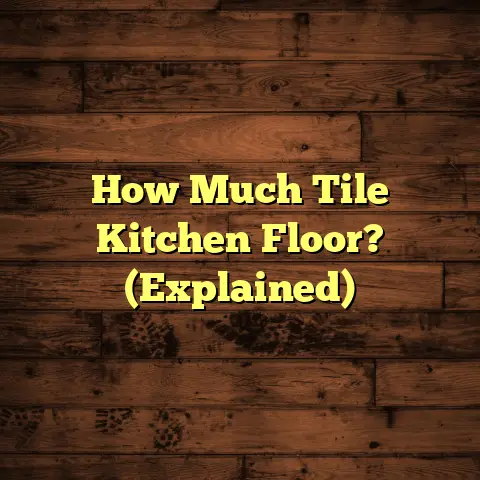Checkered Tile Texture? (4 Tactile Options!)
“Texture is the silent architect of our spaces; it defines the mood and feel of a room without uttering a single word.” – Kelly Wearstler, Interior Designer.
Checkered tile patterns are back! And they’re not just a visual treat. They add a tactile dimension that can totally transform a space.
As a flooring contractor with over 15 years in the game, I’ve seen firsthand how the right tile can make or break a room.
Let’s dive into the world of checkered tile textures and explore four tactile options that can bring your design dreams to life.
Understanding Checkered Tile Texture
So, what exactly is checkered tile texture?
It’s more than just a pattern; it’s about how the tile feels underfoot. Think back to classic diners and vintage kitchens – that’s the essence of the checkered look.
Historically, checkered patterns have been a staple in interior design for centuries. From ancient Roman mosaics to Victorian-era floors, this pattern has proven its timeless appeal.
The beauty of checkered tiles lies in their versatility. They work wonders in kitchens, bathrooms, entryways, and even outdoor spaces.
The tactile quality adds another layer of interest. A smooth, glossy tile feels different than a rough, textured stone, and that difference can dramatically impact the overall sensory experience of a room.
Tactile Option 1: Glossy Ceramic Tiles
Let’s start with a classic: glossy ceramic checkered tiles. These tiles are known for their smooth, reflective surface.
They’re like the chameleons of the flooring world.
Advantages of Glossy Ceramic Tiles:
-
Easy to Clean: Trust me, after years of dealing with spills and stains, I can tell you that glossy ceramic is a breeze to maintain. A quick wipe, and you’re good to go.
-
Brightens a Space: The reflective surface bounces light around the room, making it feel more open and airy.
-
Classic Look: There’s a reason these tiles have been around for so long. They’re timeless and add a touch of elegance to any space.
Color Combinations and Patterns:
When it comes to color combinations, the sky’s the limit. Black and white is a classic choice, but don’t be afraid to experiment with bolder colors like red and white or blue and yellow.
You can also play with different tile sizes to create unique patterns. Larger tiles can make a small room feel bigger, while smaller tiles can add a more intricate and detailed look.
Case Study:
I worked with a homeowner who wanted to recreate a vintage diner feel in her kitchen. We used glossy black and white checkered tiles and the result was stunning.
She told me that the tiles not only looked great but also made the kitchen feel brighter and more inviting.
Tactile Option 2: Matte Porcelain Tiles
Next up, we have matte porcelain checkered tiles. These tiles have a non-reflective surface that creates a warm and inviting atmosphere.
Advantages of Matte Porcelain Tiles:
-
Durability: Porcelain is incredibly durable and can withstand heavy foot traffic. I’ve seen these tiles hold up beautifully in busy households and commercial spaces.
-
Slip-Resistant: The matte finish provides better traction than glossy tiles, making them a safer option for bathrooms and kitchens.
-
Versatile Design: Matte porcelain comes in a wide range of colors and textures, allowing you to create a variety of different looks.
Colors and Textures:
Matte porcelain tiles can mimic the look of natural stone, wood, or even concrete. This versatility makes them a great choice for any design style.
Think about using a matte gray porcelain tile to create a modern, minimalist look or a matte brown porcelain tile to add warmth and texture to a rustic space.
Designer Insights:
I spoke with a designer friend of mine, Sarah, who loves using matte porcelain tiles in her projects. She told me that she appreciates the subtle elegance and the way they can ground a space.
She also mentioned that matte tiles are great for hiding dirt and scratches, which is a big plus for busy families.
Tactile Option 3: Textured Stone Tiles
Now, let’s talk about textured stone checkered tiles. These tiles, like slate or travertine, bring a natural, earthy feel to any space.
The Appeal of Textured Stone:
-
Natural Beauty: Stone tiles have a unique, organic look that can’t be replicated. Each tile is different, with its own variations in color and texture.
-
Rugged Charm: The textured surface adds a tactile element that’s both visually appealing and functional.
-
Slip-Resistance: The natural texture provides excellent grip, making them a great choice for outdoor spaces and areas prone to moisture.
Where to Use Textured Stone Tiles:
I recommend using textured stone tiles in entryways, patios, and bathrooms. They can also be used to create a stunning accent wall.
Expert Insights:
I interviewed Mark, a natural stone flooring expert, who shared some valuable insights. He emphasized the importance of sealing stone tiles to protect them from stains and water damage.
He also recommended choosing a stone that’s appropriate for the climate in your area. For example, some stones are more resistant to freezing and thawing than others.
Tactile Option 4: Vinyl Composite Tiles (VCT)
Last but not least, we have vinyl composite tiles (VCT). These tiles are known for their affordability, durability, and ease of installation.
Benefits of VCT:
-
Affordability: VCT is one of the most budget-friendly flooring options available.
-
Ease of Installation: These tiles are easy to cut and install, making them a great choice for DIY projects.
-
Low Maintenance: VCT is easy to clean and maintain. Regular sweeping and mopping are usually all that’s needed.
Patterns and Textures:
VCT comes in a wide range of patterns and textures, including options that mimic the look of natural stone and wood.
This makes it a versatile choice for any design style.
Real-Life Examples:
I’ve seen VCT used successfully in a variety of settings, from schools and hospitals to restaurants and retail stores.
I even worked on a project where we used VCT to create a checkered floor in a retro-themed ice cream parlor. The result was fantastic!
Conclusion
So, there you have it: four tactile options for checkered tile textures. Each option offers its own unique set of advantages and can contribute to the overall aesthetic and functionality of your interiors.
Remember, the key is to consider how the texture of the tile will impact the overall feel of the space. Do you want a smooth, reflective surface that brightens the room?
Or do you prefer a rough, textured surface that adds warmth and character?
Ultimately, the choice is yours. But with a little bit of planning and research, you can create a checkered tile floor that’s both beautiful and functional.





